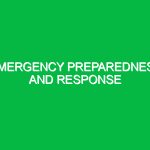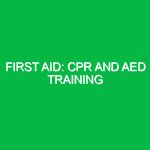Introduction
In the unpredictable landscape of workplace environments, the importance of developing an emergency action plan (EAP) cannot be overstated. An EAP serves as a structured, proactive framework designed to prepare organizations for potential emergencies, ensuring the safety of employees, the environment, and the surrounding community. The stakes are high; a well-crafted EAP can minimize chaos, reduce injuries, and ultimately save lives. But what does it mean to develop such a plan, and why is it vital within the Health, Safety, and Environment (HSE) domain?
Drawing from personal experiences, I can share a poignant lesson learned during a fire drill at a manufacturing plant. The alarm rang, and while some employees rushed out, others hesitated, unsure of where to go. This lack of preparation illustrated the need for a comprehensive EAP. It’s not merely about having a plan; it’s about ensuring everyone understands it. In this article, we’ll delve into the intricacies of developing an emergency action plan, identifying hazards, outlining safety precautions, and highlighting relevant regulations.
Identifying Potential Hazards and Risks
When embarking on the journey of developing an emergency action plan, the first step is identifying potential hazards. In the HSE domain, hazards can manifest in various forms, including physical, chemical, biological, and environmental risks.
Types of Hazards
1. **Physical Hazards**: These include slip and fall incidents, machinery accidents, and electrical hazards. For instance, in a construction site, the risk of falls from heights presents a significant challenge. According to the Occupational Safety and Health Administration (OSHA), falls are one of the leading causes of workplace fatalities.
2. **Chemical Hazards**: Exposure to toxic substances can lead to severe health implications. A notable example is the case of a chemical spill in a laboratory setting, which not only posed immediate risks to personnel but also had long-term environmental consequences. Understanding Material Safety Data Sheets (MSDS) is crucial for managing these risks effectively.
3. **Biological Hazards**: These are often overlooked but can be equally dangerous. The COVID-19 pandemic underscored the need for plans addressing infectious diseases. Developing protocols for sanitation and contact tracing became paramount for many organizations.
4. **Environmental Hazards**: Natural disasters like floods, earthquakes, and hurricanes can disrupt operations and threaten safety. For example, a manufacturing facility located in a flood-prone area must have a clear plan for evacuation and securing equipment.
Risk Assessment
After identifying potential hazards, conducting a risk assessment is essential. This involves evaluating the likelihood of each hazard occurring and the potential impact on personnel and operations. The risk matrix, a tool often used in this assessment, helps prioritize risks based on their severity and probability.
Developing the Emergency Action Plan
Once hazards are identified and assessed, the next step in developing an emergency action plan is structuring the plan itself. Below are key components to consider.
1. Emergency Response Procedures
Clearly defined emergency response procedures are the backbone of any EAP. These procedures should outline the steps employees should take in various emergencies, such as fire, chemical spills, or severe weather. For instance, during a fire, employees should know the nearest exit routes and assembly points.
2. Roles and Responsibilities
An effective EAP must delineate roles and responsibilities among employees. Assigning specific individuals as emergency coordinators, first aid responders, and evacuation leaders fosters accountability and ensures that everyone knows who to turn to in a crisis.
3. Communication Plan
A robust communication plan is vital for keeping everyone informed during an emergency. This includes establishing clear lines of communication and ensuring that all employees understand how information will be disseminated. Consider using multiple channels, such as emails, text messages, and public address systems, to reach everyone.
4. Training and Drills
A plan is only as good as its execution. Regular training sessions and drills are critical for ensuring that all employees are familiar with the EAP. For example, conducting fire drills not only tests the effectiveness of your plan but also reinforces the importance of preparedness among staff.
Best Practices for Safety Precautions
To complement the EAP, certain safety precautions and best practices should be integrated into daily operations.
1. Regular Maintenance and Inspections
Regular maintenance of equipment and facilities can significantly reduce the risk of accidents. For instance, in the case of a chemical storage area, routine inspections can identify leaks or deterioration before they lead to a hazardous situation.
2. Employee Training and Awareness
Beyond initial training, continuous education on safety practices is essential. Employees should be regularly updated on new protocols, safety equipment, and emergency procedures. This could include workshops, safety briefings, or e-learning modules.
3. Safety Equipment and Resources
Providing appropriate safety equipment is non-negotiable. This includes personal protective equipment (PPE) such as helmets, gloves, and respirators, depending on the potential hazards associated with specific roles.
4. Emergency Supplies
Ensure that emergency supplies, including first aid kits, fire extinguishers, and emergency lighting, are readily available and easily accessible. Regular checks should be conducted to replenish any supplies that may have been used or expired.
Regulations and Standards for Emergency Action Plans
Navigating the regulatory landscape is crucial when developing an emergency action plan. Various standards and regulations govern EAPs, depending on the industry.
1. Occupational Safety and Health Administration (OSHA)
OSHA mandates that employers have an emergency action plan for their workplaces. According to OSHA’s standards, an EAP must include procedures for reporting emergencies, evacuation plans, and procedures for employees who remain behind to operate critical equipment before evacuating.
2. National Fire Protection Association (NFPA)
The NFPA provides guidelines on fire safety and emergency planning. Their standards emphasize the need for regular training and drills to ensure preparedness for fire-related incidents.
3. Environmental Protection Agency (EPA)
For facilities that handle hazardous materials, the EPA requires specific emergency response plans to mitigate environmental risks. Compliance with the Resource Conservation and Recovery Act (RCRA) is essential for waste management and spill response.
Conclusion
Developing an emergency action plan is not just a regulatory requirement; it is a moral obligation to protect employees and the environment. A comprehensive EAP addresses the identification of hazards, the establishment of clear procedures, and the implementation of safety measures. By fostering a culture of preparedness and continuous improvement, organizations can significantly mitigate risks and enhance overall safety.
The journey of developing an emergency action plan is ongoing. Regular reviews and updates are necessary to adapt to new challenges and ensure that every employee is equipped with the knowledge and tools needed to respond effectively to emergencies. Remember, in the realm of health, safety, and environment, proactive planning is the key to resilience.


